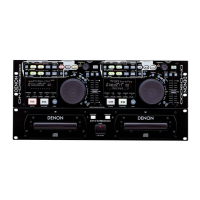
Do you have a question about the Denon DN-D9000 and is the answer not in the manual?
Crucial warnings about electric shock, fire hazards, and avoiding moisture.
Guidelines for safe operation, including cord handling, ventilation, and maintenance.
Visual guide to the DN-D9000's front panel layout and primary controls.
Identifies and explains the purpose of rear panel ports for connectivity.
Advises on environmental conditions, cleaning, and handling the unit.
States adherence to relevant electronic and safety standards.
Caution against using a specific cleaner that may damage the laser pickup.
Highlights structural aspects like removable drives, rack mounting, and display visibility.
Explains core DJ functions such as Scratch, Loops, Sampler, and Alpha playback modes.
Details advanced operations like Effects, Memo, Pitch/Key adjustment, and playback modes.
Guide to connecting the DN-D9000 to mixers and other compatible equipment.
Instructions for linking Fader Start and X-Effect functions with DENON mixers.
Explains controls for playback, cueing, time display, memory, and platter effects.
Details controls for track selection, effects, pitch adjustment, and scratch functions.
Explains functions for loop management, sampler recording, and Hot Start points.
Details controls for Alpha-Track playback and setting splice points.
Comprehensive guide to interpreting all indicators and displays on the unit.
Guidelines for proper handling, cleaning, and storage of compact discs.
How to start, pause, and cue tracks for playback management.
Adjusting playback speed using the pitch slider and pitch bend buttons.
Instructions for activating and controlling the scratch function.
Steps for playback, pausing, and manipulating Alpha Tracks.
How to adjust the pitch and volume level for Alpha Tracks.
Guide to entering Alpha Mode and monitoring the Alpha Track output.
Procedures for seamless switching between tracks and exiting Alpha Mode.
How to set A and B points for seamless loops and hot start playback.
Instructions for stutter playback and clearing loop/hot start points.
Step-by-step guide to setting splice start and end points.
How to initiate splice playback and clear set splice points.
Choosing between A/B Trim for fine-tuning and A/B Move for repositioning points.
Detailed steps for fine-tuning and saving loop and splice points.
Guide to selecting operational modes for A3/A4 buttons.
Instructions for recording, playing, and looping samples.
Managing sampler playback, including exiting, reverse play, and moving the B point.
Adjusting sampler volume/pitch and clearing stored sampler data.
How to select and activate various platter effects like Drag, Brake, and Echo.
Procedure for disabling all active platter effects simultaneously.
Choosing the audio source and effect type (Delay, Flanger, Transform, Filter).
Fine-tuning effect parameters, holding effects, and bypassing.
How to save settings like cue points, pitch, and modes into memory.
Procedures for managing memory capacity, clearing data, and copying settings.
Steps to enter preset mode and navigate through available settings.
Overview of configurable presets including Auto Cue, Pitch Range, and Alpha Track output.
Managing presets by clearing program/memo data and copying settings.
How to input, clear, and save tracks for programmed playback.
Procedures for starting, cancelling, storing, and recalling programmed playback.
Instructions for setting up and initiating random track playback.
How to configure and use relay playback and power-on playback features.
Technical details including dimensions, weight, power requirements, and disc compatibility.
Technical specifications for audio output levels, frequency response, and digital output.
Technical performance details for functions like Instant Start, Pitch, and Sampler.
